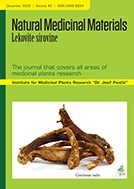Institute for Medicinal Plants Research "Dr. Josif Pančić" , Belgrade , Serbia
Institute for Medicinal Plants Research "Dr. Josif Pančić" , Belgrade , Serbia
Hydrolats are valuable co-products of the essential oil distillation process, whose volatile compounds can be quantified by various methods. In this paper, we have tried to estimate the liquid-liquid extraction cycle number threshold for volatile compounds quantification of lavandin (Lavandula x intermedia) hydrolat. For this purpose, ten consecutive hydrolat extractions with \textit{n}-hexane were analyzed GC/MS with hexadecane (C16) as an internal standard and compared with the lavandin essential oil. The chemical composition of the lavandinhydrolat showed similarity with its essential oil to the great extent, while volatile compounds dissolved in hydrolat exclusively belonged to the class of oxygenated monoterpenes. The total amount of extracted compounds has been estimated to 2174.2 mg/L, where the most dominant compounds in lavandinhydrolat were cis- and trans-furanoidlinalool oxide (676.3 and 634.1 mg/L, respectively), followed by much smaller amounts of linalool, camphor, and 1,8-cineole (167.6, 157.0, and 148.2 mg/L, respectively). Cumulative recoveries of total compounds yield after the third, fifth, and eighth extractions were 88 %, 96 %, and 99 %, respectively. Combined fraction analysis confirmed that in the first 5 cycles more than 95 % of the total yield (from 10 cycles) of extracted volatile compounds can be collected. Based on the results of this study, for volatile compounds quantification in lavandinhydrolat, 5 cycles of \textit{n}-hexane liquid-liquid extraction can be recommended.
This is an open access article distributed under the Creative Commons Attribution License which permits unrestricted use, distribution, and reproduction in any medium, provided the original work is properly cited.

The statements, opinions and data contained in the journal are solely those of the individual authors and contributors and not of the publisher and the editor(s). We stay neutral with regard to jurisdictional claims in published maps and institutional affiliations.